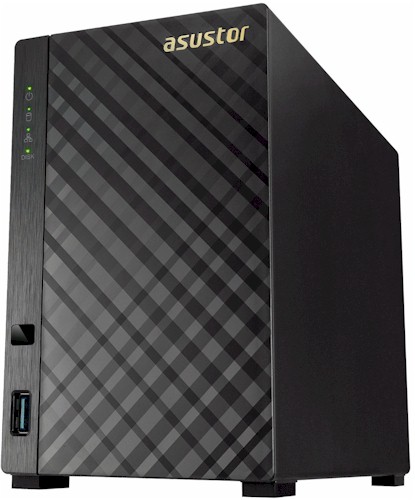
| At a glance | |
|---|---|
| Product | ASUSTOR NAS Server (AS1002T) [Website] |
| Summary | Two-bay dual-core Marvell NAS with wide range of downloadable apps. |
| Pros | • Wide range of downloadable apps • Quiet |
| Cons | • Slow attached backup |
Typical Price: $0 Buy From Amazon
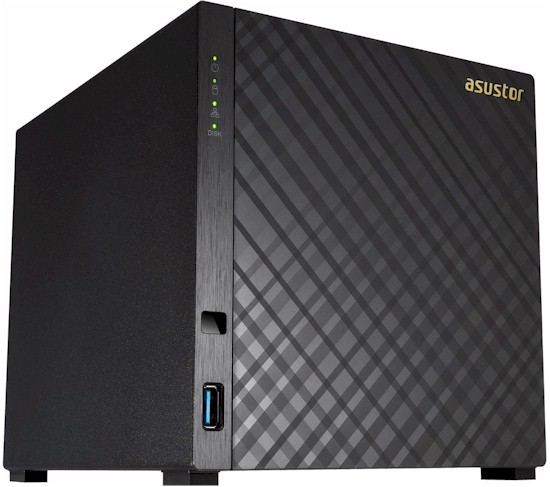
| At a glance | |
|---|---|
| Product | ASUSTOR NAS Server (AS1004T) [Website] |
| Summary | Four-bay dual-core Marvell NAS with wide range of downloadable apps. |
| Pros | • Wide range of downloadable apps • Quiet |
| Cons | • Slow attached backup • RAID 5 write much slower than read |
Typical Price: $0 Buy From Amazon
Introduction
ASUSTOR has been refreshing its NAS lines and we’ve reviewed most of them. This review covers two new models in its “Personal to Home” family, the AS1002T two-bay and AS1004T four-bay NASes.
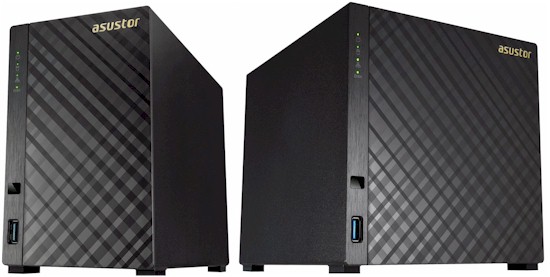
The chart below generated on the ASUSTOR website shows key differences in this family. First, the AS100xT models are powered by Marvell Armada processors; the AS-20xT models are powered by Intel Atoms. Both processors are dual core. The AS100xT NASes also have less memory (512MB non expandable vs. 1GB), fewer USB ports and lack the HDMI and audio output ports found on the AX-20xTE NASes. However, the AS100xT NASes have a hardware encryption engine that’s missing on the AS-20xTE NASes.
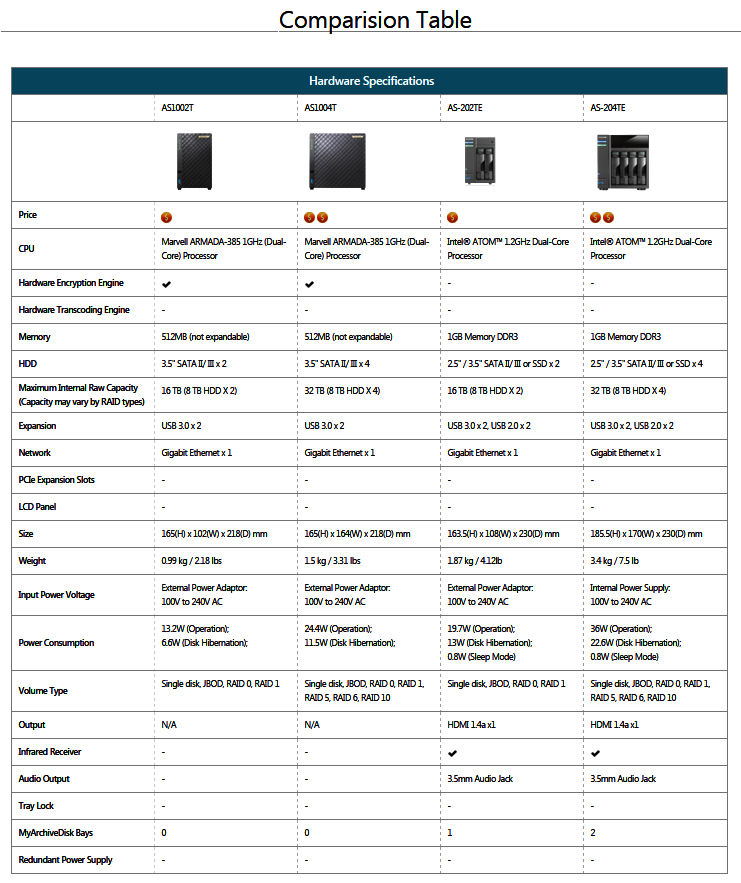
ASUSTOR AS100xT and AS-20xT product comparison
The AS100xT NASes, along with the new AS310xT NASes feature a new look. Rather than having the disks exposed, each of the NASes has a diamond-plate embossed solid front panel. Aside from looks, this means these models do not have hot-swappable drives.
There is a new Quick Installation Guide common to both AS100xT NASes. There wasn’t a complete front panel view available in the quick start guide, but the LED callouts below show what you really need to know. From the product shots at the top of the page you can see that there’s a single USB 3.0 port on the front panel. Unfortunately, with the new case design, you can’t see activity indicators for the individual drives as you can on other ASUSTOR models. There’s a single LED indicator to show disk activity.
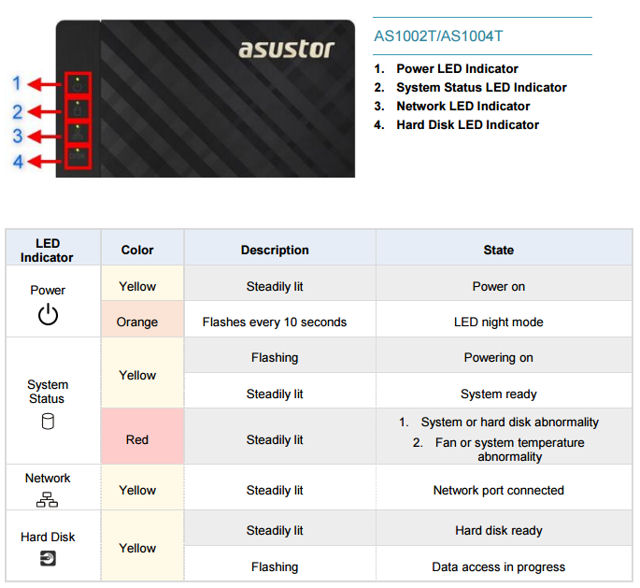
ASUSTOR AS100xT front panel LED indicators
The image below shows the rear panel callouts. There’s a single USB 3.0 port and a single Gigabit Ethernet port. The image below shows the AS1004T which, like other ASUSTOR four-bay NASes, uses a 120mm fan. The AS1002T, like other ASUSTOR two-bay NASes, uses a 70mm fan.
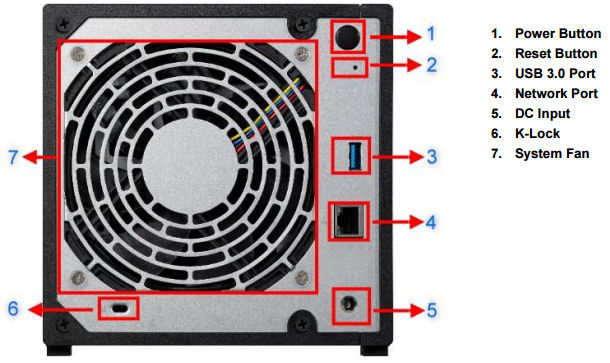
ASUSTOR AS100xT rear panel callouts
Inside
Like many ASUSTOR NASes, our AS1004T test unit was very easy to disassemble. As the quick start guide shows, you can easily disassemble the case without tools. The image below shows the inside looking at the front with the case removed. You can see the four eSATA connectors on the drive backplane.
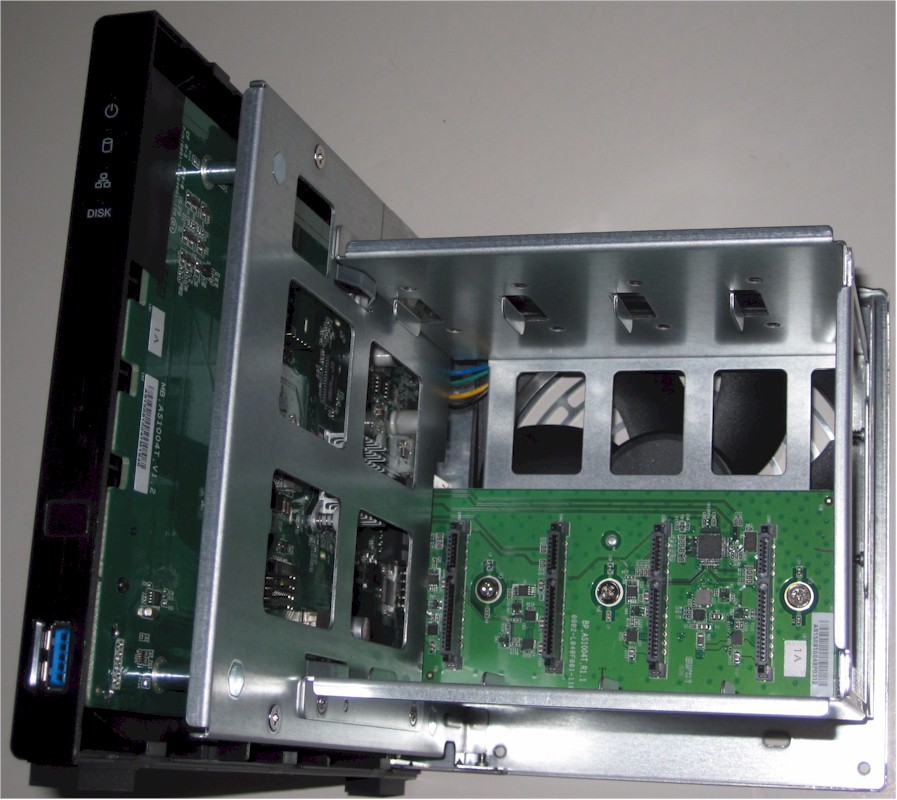
ASUSTOR AS1004T inside view
The image below shows the main board with the heatsink in place covering the processor. The rear panel connectors are on the left side of the image.
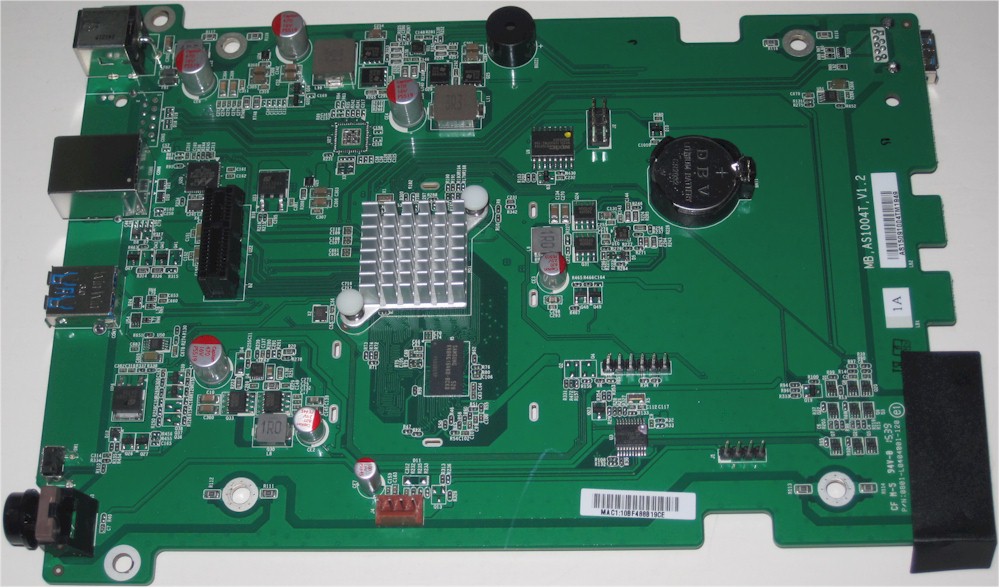
ASUSTOR AS1004T main board
For comparison in this review, we’ll be using the ASUSTOR AS-202TE and AS-204TE. In addition, for the two-bay comparison, we’ll be using the recently reviewed Western Digital My Cloud Gen 2. Four our four-bay comparison, we’ll be comparing the two ASUSTOR NASes with the Western Digital My Cloud Expert Series EX4100.
The table below shows the key component summary for the products being used in our comparisons.
| ASUSTOR AS1004T | ASUSTOR AS-204TE | WD My Cloud Mirror Gen 2 | WD My Cloud EX4100 | |
|---|---|---|---|---|
| CPU | Marvell ARMADA-385 @ 1GHz dual-core | Intel Atom CE5310 @ 1.2 GHz (dual core) | Marvell ARMADA 38X (88F6820-A0) Dual-Core ARM Cortex-A9 @ 1.33 GHz | Marvell dual-core Armada 388 @ 1.6 GHz |
| RAM | 512 MB Samsung K4B4G1646D | 1 GB DDR3 on board | 512 MB Nanya NT5CC128M16FP-DI (x2) | 2 GB DDR3 (Hynix H5TQ4G83AFR x4) on board not upgradeable |
| Flash | 16 MB Macronix MX25L12835 | 16 MB Spansion FL128SAIF00 | 256 MB Hynix H27U2G8F2CTR (x1) | 512 MB Hynix H27U4G8F2DTR |
| Ethernet | Realtek RTL8211E | Realtek RTL8211E | Marvell 88E1512-NNP2 Gigabit Ethernet Transceiver | Marvell 88E1512 (x2) |
| USB 3.0 | In CPU | Etron Tech EJ188H | In Marvell ARMADA 38X processor | Renesas D720120 |
| SATA | Marvell 88SE9170 2 port SATA controller (on drive backplane for AS1004T) | Asmedia ASM1061 PCI Express to two ports of Serial ATA (on back plane – AS-204TE only) | In Marvell ARMADA 38X processor | In CPU |
Table 1: Component summary and comparison
With two drives, the NAS drew 14 W with WD Red 1 TB (WD10EFRX) drives spun up and 8 W with the drives spun down for power save. With four drives loaded, the power draw was 20 W active and 10 W in power-save. Noise was rated as low. RAID 10 rebuild time was 3 hours and 7 minutes for a 4 X 1 TB configuration.![]()
Features
The AS100xT NASes are powered by the recently upgraded ADM 2.5 operating system. It’s important to note that the new ADM 2.5 uses a different file structure, and you can’t roll back to a previous version of ADM after upgrading. To find out more, you can check out the new features of ADM 2.5 here.
New features include:
- iSCSI LUN snapshots with up to 256 snapshot versions per LUN
- Internal backup to drives designated as “MyArchive” hard disks
- Enhanced Network Recycle Bin based on shared folders rather than storage volumes
- DataSync for Microsoft One Drive (OneDrive for Business not supported by the app).
Note: These are the new features of ADM 2.5. AS100xT NASes don’t support MyArchive.
ASUSTOR also has a Live Demo if you want to wrap your hands around the UI and check out some of the new features. If you want to learn more about the ASUSTOR NAS or want to get more out of the ASUSTOR NAS that you already own, be sure to check out the ASUSTOR College. The image below shows the landing page on the AS1004T test unit.

ASUSTOR ADM 2.5 landing page on AS1004T evaluation unit
Performance
ADM 2.5.0.R9B2 firmware was loaded onto an AS1004T and performance tests were run using the Revision 5 NAS test process. Since the AS1002T uses the same processor, RAM and Ethernet components, all testing was done on the AS1004T. The AS1004T tests used four drives configured in single RAID 0, 5 and 10 volumes. The AS1002T tests used two drives in single RAID 0 and 1 volumes. All tests were run using Western Digital Red 1 TB (WD10EFRX) drives (x4 SNB supplied).
The composite image below shows how the AS1002T and the AS1004T compare to other products for File Copy Write Performance. The File Copy Write test the AS1002T turned in 108.1 MB/s – slightly below the slightly better performing NASes clustered around 110 MB/s. The AS1004T, at 107.5 MB/s was slightly slower than the other top ranking NASes. Note that quite a few NASes in both charts are clustered around 110 MB/s. That’s about the maximum throughput that can be achieved with single client Gigabit Ethernet testing.
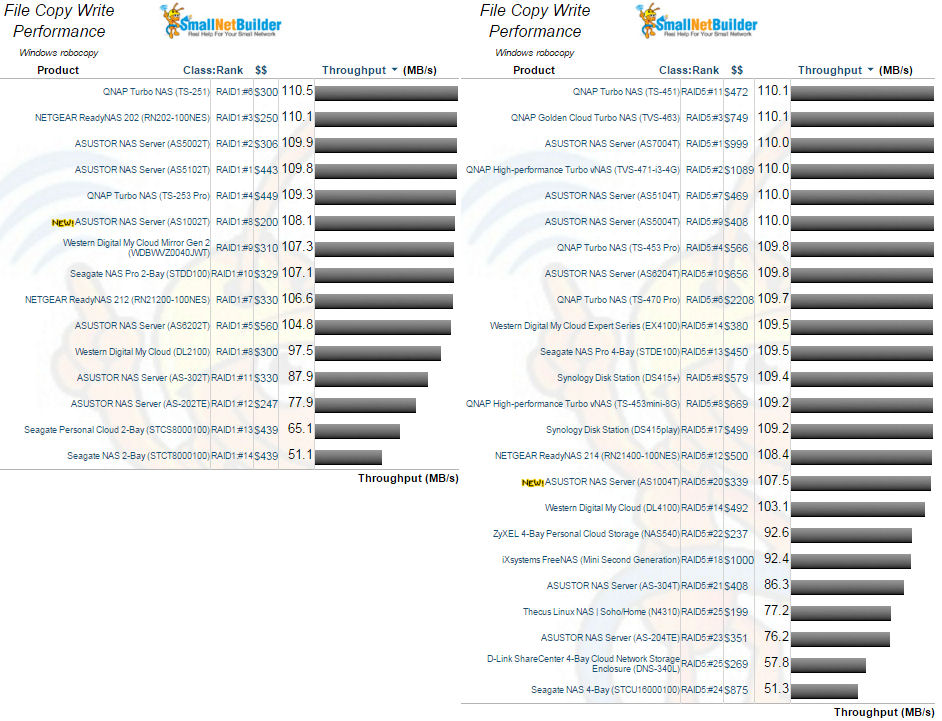
File copy write performance comparison
Performance – Two Bay
As noted above, for the two drive comparison, I chose the ASUSTOR AS-202TE and the Western Digital My Cloud Mirror Gen2, which are shown in the benchmark summaries below. The ASUSTOR AS1002T turned in better than 100 MB/s for all File Copy read and write operations except for RAID 1 File Copy Read which was 94.5 MB/s.
The WD My Cloud Mirror Gen2 had very similar performance except for RAID 1 File Copy Write which was only 88.3 MB/s. Both of those NASes significantly outperformed the AS-202TE on most tests. The only area where the AS-202TE did better than the AS1002T was on iSCSI Write and Reads. (The WD Mirror Gen 2 doesn’t support iSCSI.) The AS1002T had the poorest USB 3 backup performance of the three by a significant margin.
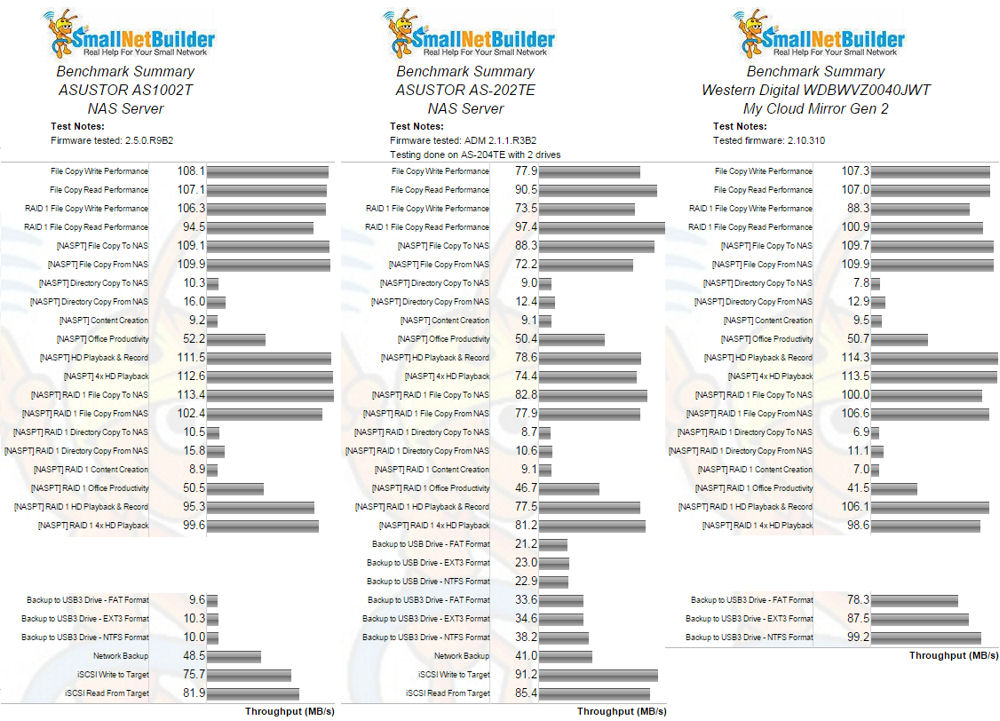
Benchmark summary comparison – two bay
The NAS Ranker, filtered for RAID1 and Revision 5 testing shows the ASUSTOR AS1002T ranked #8, between the NETGEAR ReadyNAS 212 at #7 and WD DL2100 at #9. The AS-202TE ranks near the bottom of the charts at #13.
If you sort the RAID 1 NAS Ranker by price, you’ll generate the chart below. The $200 AS1002T is the cheapest two-bay NAS. Spending an extra $50 moves you up to the #4 ranked NETGEAR ReadyNAS 202.
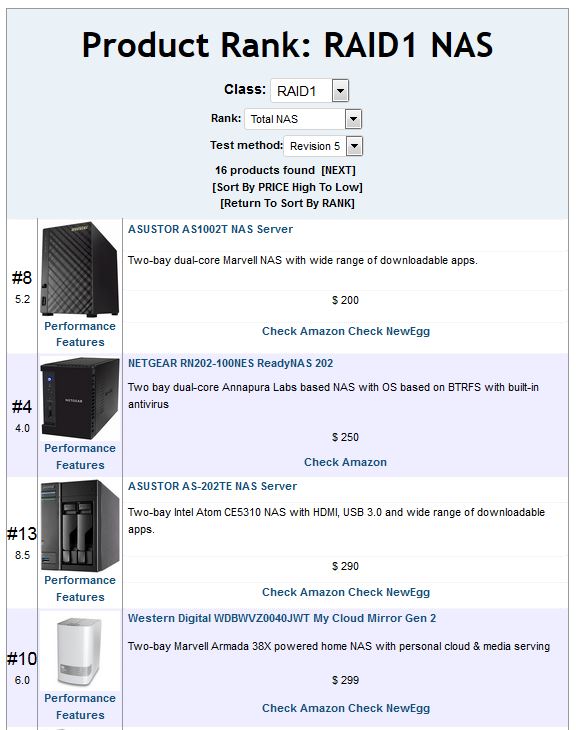
RAID1 NAS Rank – price sort
The chart below shows individual and category scores for the same three NASes shown in the two drive benchmark summaries above. The AS1002T outperformed the other two NASes for the Write, Read and Mixed Read categories. It placed second behind the WD My Cloud Mirror Gen 2 for the Video category. Not surprisingly based on the benchmark results, the AS1002T’s total NAS rankings were pulled down by poor backup performance. Given the backup tests were abnormally low, a RAID1 volume was re-created after RAID 5 tests were done and the test repeated. Results did not change.
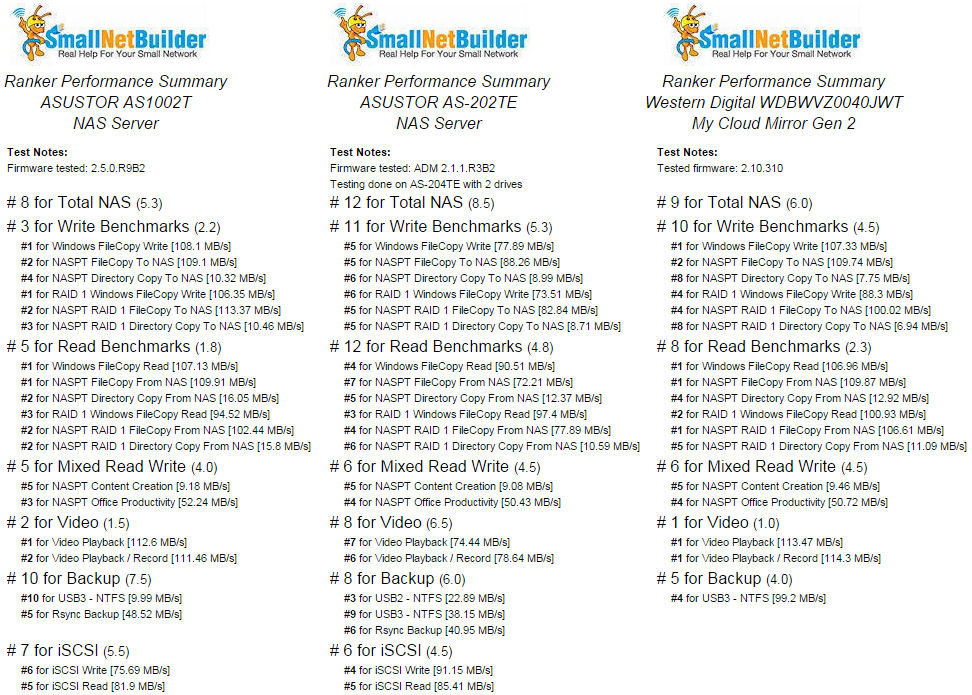
Ranker Performance Summary comparison
Performance – Four Bay
For four drive NASes, I compared the AS1004T, ASUSTOR AS-204TE and Western Digital My Cloud Expert Series EX4100. With one exception, both the AS1004T and the WD EX4100 came close to maxing out the throughput of a single Ethernet client at well over 100 MB/s for File Copy Write and Read performance for all RAID levels. The exception was the AS1004T, that exhibited lower RAID 5 file copy write performance of 79.0 MB/s. Similarly, the AS1004T had lower than expected results (87.0 MB/s) for NASPT File Copy to NAS for RAID 5. The RAID 10 NASPT file copy tests for both read and write for the AS1004T as well as the WD EX4100 were over 100 MB/s.
While the AS1004T turned in better USB 3.0 backup results than the AS1002T, the results for both it and AS-204TE fell significantly below the excellent USB 3.0 backup performance of the WD EX4100. Of the three NASes compared, the AS1004T has the slowest iSCSI Write and Read performance. Notably, the AS1004T’s iSCSI write was quite a bit slower than iSCSI read – 64.4 MB/s and 81.4 MB/s respectively.
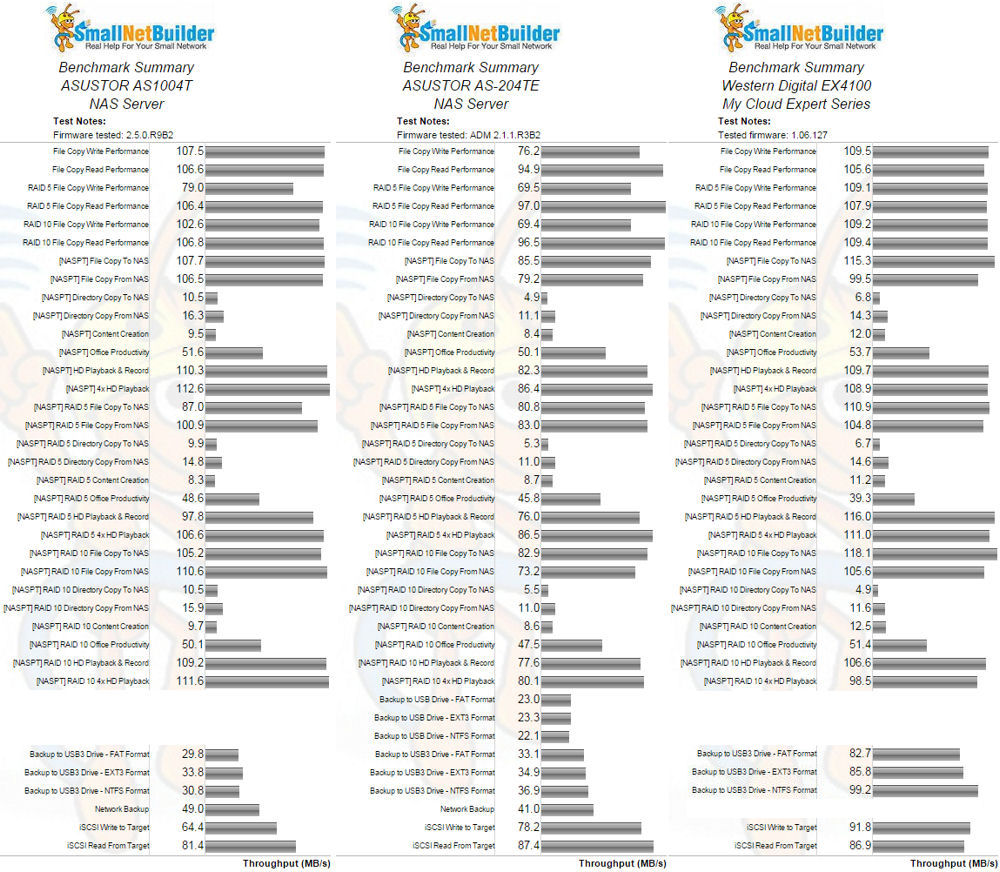
Four bay benchmark summary comparison
Using the NAS Ranker to show RAID5 products, ranks the AS1004T at #20, just above its AS-304T sibling. Even though ranked at #20, the AS1004T provides the best bang for the buck at $339. To get a higher-ranked product, you need to move up to the diskless WD EX4100 at #14 for $380.
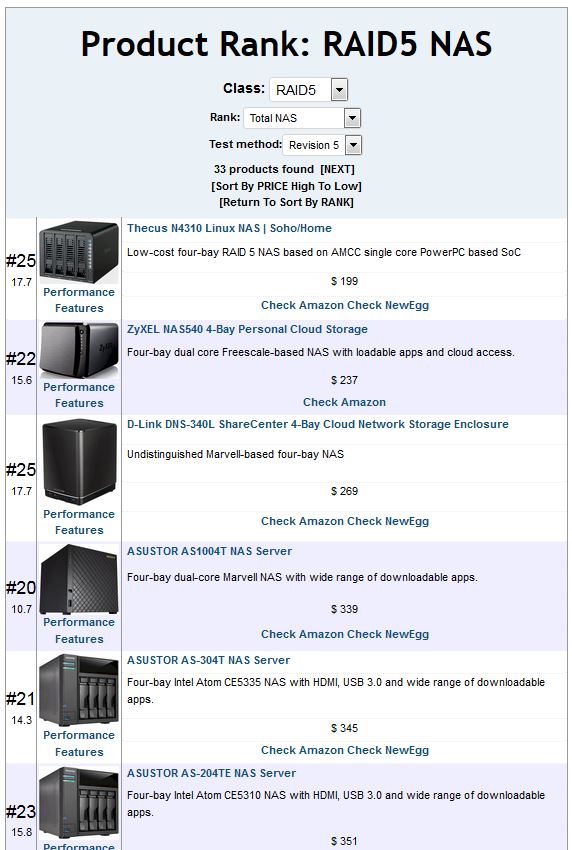
RAID5 NAS Rank – price sort
Looking at the RAID 5 performance subcategories, there weren’t really any surprises based on the benchmark summary chart. The AS1004T outperformed the WD EX4100 for Write, Read and Video benchmark categories. The EX4100 held a slight edge for mixed the Read Write category, and was the clear winner for USB Backup and held a slight edge over the other two for the iSCSI category.
The AS1004T’s low performance on iSCSI Write and Read dragged it below the category rankings for both the AS-204TE and the EX4100. The AS-204TE had significantly poorer performance than the other two NASes for both Write and Read benchmarks ranking #24 and #21 respectively.
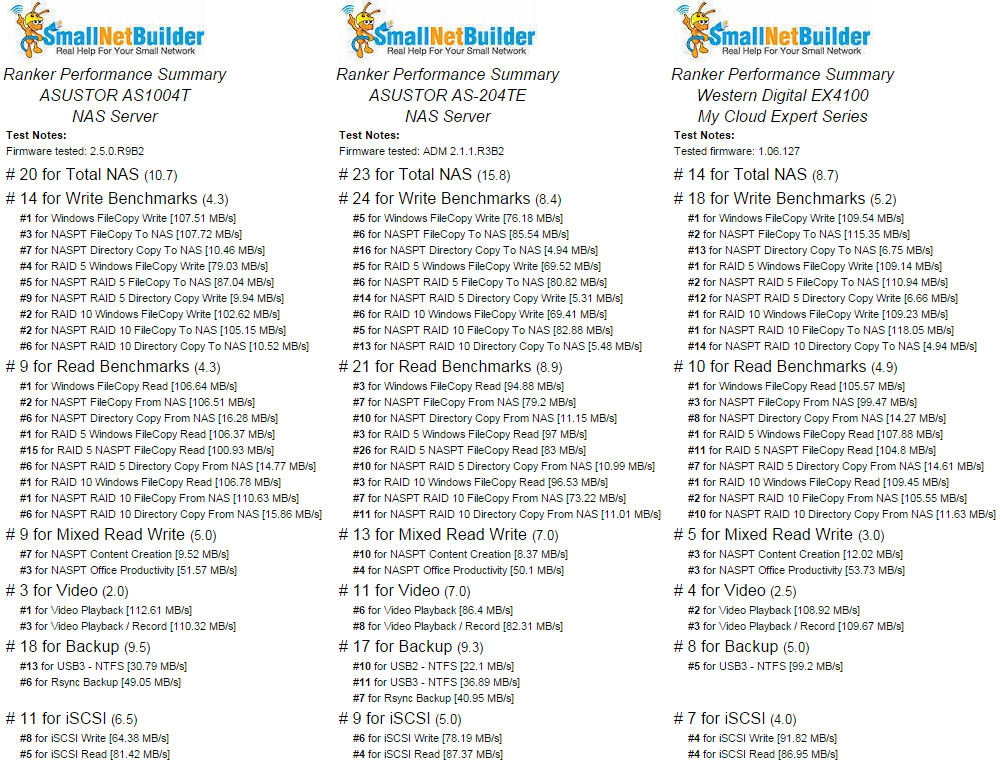
Ranker Performance Summary
Closing Thoughts
For two-bay NASes, ASUSTOR has the two least expensive products of the ones that we’ve recently tested. The #8 ranked AS1002T is $200, and from a performance perspective, outperforms the next most expensive NAS, the #12 ranked $247 ASUSTOR AS-202TE. Of course, the AS1002T lacks the HDMI/Audio output capabilities that might make the AS202TE a more attractive option for someone looking to connect their NAS to a HDTV. The #3 ranked NETGEAR RN202-100NES priced at $250 also will give you a bump in performance as well as BTRFS snapshot capabilities if you’re willing to cough up a 25% premium over the AS1002T.
For four-bay NASes, the AS1004T, like its sibling, offers a lot of performance for the dollar. Bear in mind that for RAD 5 capable NASes, we have significantly more products in our chart, and some of them are significantly more expensive. Ranked at #20 with a price of $339, there are no other RAID5 NASes that offer better performance for less money. But the competition is stiffer in the RAID5 capable market. In only costs about 40 bucks more to move up from #20 to the #14 ranked Western Digital EX4100 or about $70 to move up to the #9 ranked AS5004T.
In looking at the ASUSTOR lineup, it looks like there are some models that could soon will become redundant. With the exception of the HDMI capabilities of the AS-20xTE products, the AS100xT is a better performing replacement for less money. Similarly, with the ASUSTOR AS-304T having the same price as the AS5004T but with a significantly lower ranking, you have to wonder how long before the AS-30xT line will be discontinued.
In many of our reviews of ASUSTOR NASes, we’ve concluded that ASUSTOR offers a lot of bang for the buck. The performance of many of their products nears the top of the charts at very aggressive prices. The new AS100xT series is no exception.
